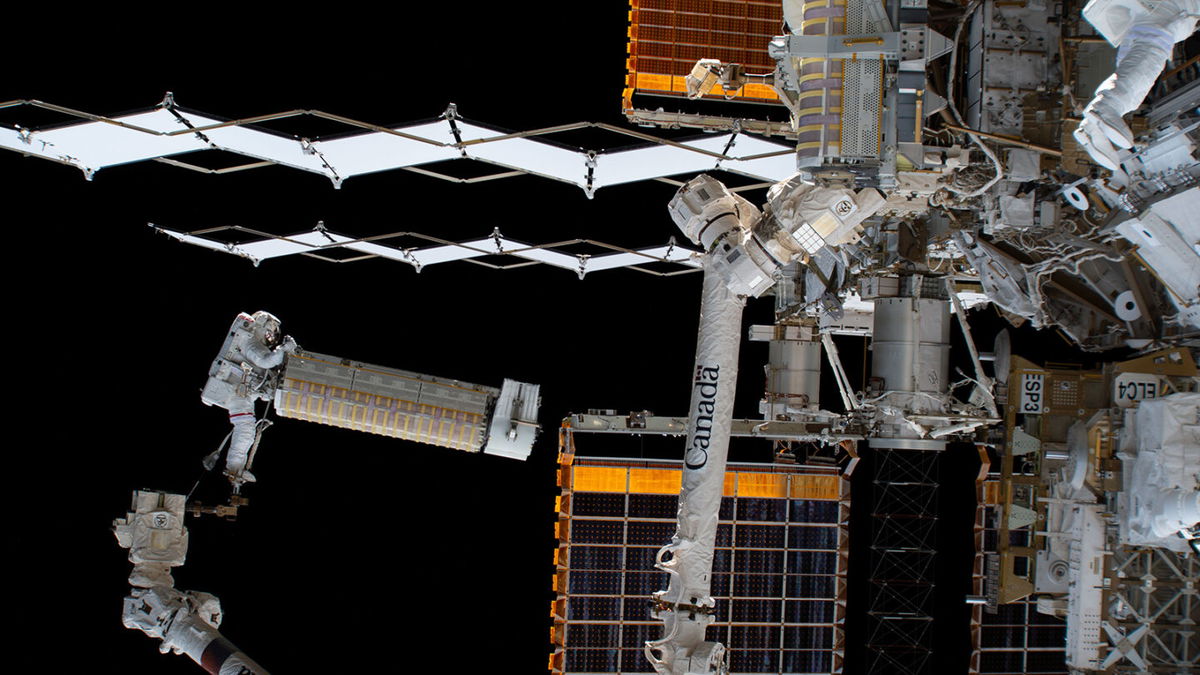Astronauts complete spacewalk after space debris triggered one-day delay

The International Space Station is set to receive its second solar power boost in a month during a spacewalk on December 22.
By Ashley Strickland and Jackie Wattles, CNN
The International Space Station got its second solar power boost in a month as two NASA astronauts carried out a spacewalk to install a new solar panel. The event comes after a piece of wayward space garbage interfered with plans to carry out the spacewalk Wednesday.
NASA was forced to implement a 24-hour delay so that the space station could fire up its thrusters to move out of the way of the debris, which was identified as a fragment of an old Russian rocket. Near-collisions in space are common, as low-Earth orbit — the area in which the ISS orbits — is becoming increasingly congested with satellites and space junk.
“The crew is not in any immediate danger,” NASA noted in a blog post Wednesday.
The spacewalk kicked off Thursday around 8:30 a.m. ET and lasted about seven hours.
NASA astronauts Josh Cassada and Frank Rubio installed a new solar array, called an iROSA, outside the floating laboratory. Rubio is serving as extravehicular crew member 1 and is wearing a suit with red stripes, while Cassada is wearing an unmarked white suit as extravehicular crew member 2.
The solar array deployed around 2 p.m. ET, finishing off the primary goal of the spacewalk. Rubio and Cassada returned to the ISS airlock, concluding the event, about an hour later.
Cassada and Rubio already installed one solar array outside the space station during a spacewalk on December 3. And the first two iROSAs were deployed outside the station in June 2021. The plan is to add six total, which will likely boost the space station’s power generation by more than 30% once all are operational.
Two more arrays were delivered to the space station on November 27 aboard the 26th SpaceX Dragon commercial resupply mission, which also carried dwarf tomato seeds and other experiments to the orbiting laboratory. Rolled up like carpet, the arrays weigh 750 pounds (340 kilograms) each.
The solar array installed Thursday will increase capacity in one of the space station’s eight power channels, located on its port truss. During a webcast of the spacewalk, a NASA commentator confirmed the newly installed iROSA was already generating power for the ISS.
Fully unfurled, the solar array measures about 63 feet (19 meters) long and 20 feet (6 meters) wide.
The original solar arrays on the space station are still functioning, but they have been supplying power for more than 20 years and are showing signs of wear after long-term exposure to the space environment. The arrays were originally designed to last 15 years.
Erosion can be caused by thruster plumes, which come from both the station’s thrusters and those of the crew and cargo vehicles that come and go from the station, as well as micrometeorite debris.
The new solar arrays are being placed in front of the original ones. It’s a good test because equipment using this same design will power parts of the planned Gateway lunar outpost, which will help humans return to the moon through NASA’s Artemis program.
The new arrays will have a similar 15-year life expectancy. However, since the degradation on the original arrays was expected to be worse, the team will monitor the new ones to test their longevity because they may last longer.
While US spacewalks continue, Russian ones conducted by cosmonauts aboard the space station are on hold following the discovery of a coolant leak from the Soyuz MS-22 spacecraft, which is docked to the Russian segment of the space station.
The leak was found December 14 ahead of a planned Russian spacewalk, when liquid began spewing out from the Soyuz.
The external radiator cooling loop of the Soyuz is the suspected leak source, according to a December 15 update from NASA.
While the space station crew remained safe, investigation of the leak is ongoing. During a news conference Thursday, NASA’s ISS program manager, Joel Montalbano, said it’s still not clear what caused a 4-millimeter hole in the spacecraft, though it could have been a piece of spaceborne debris or a hardware issue.
NASA and its Russian counterpart, Roscosmos, are still evaluating if the spacecraft is safe to carry a crew.
The Soyuz MS-22 ferried NASA’s Rubio and two Russian cosmonauts to the space station on September 21 and was scheduled to bring them back to Earth in March.
The-CNN-Wire
™ & © 2023 Cable News Network, Inc., a Warner Bros. Discovery Company. All rights reserved.
CNN’s Ross Levitt and Katia Hetter contributed to this report.